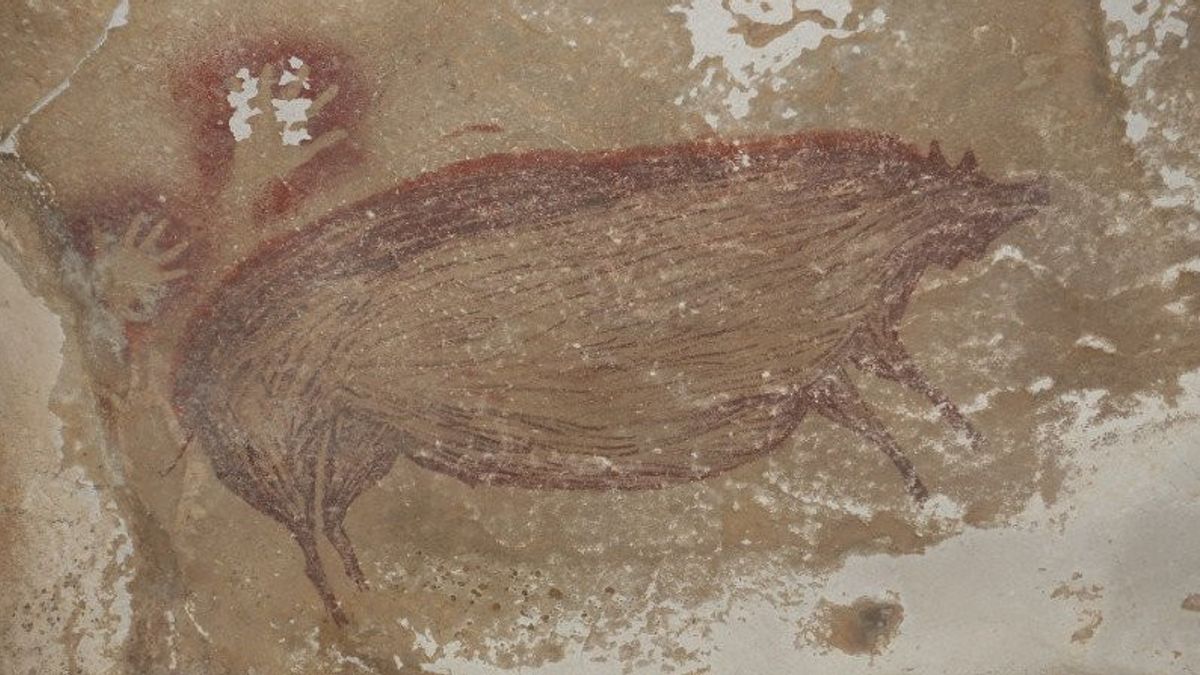MAKASSAR - Collaborative research between the National Archaeological Research Center (Puslit Arkenas) and Griffith University Australia found images of warty pigs in Leang Tedong, Maros, South Sulawesi. This finding is the oldest cave painting in the world, which is about 45,500 years old.
The findings, published in the journal Science Advances on Wednesday, January 13, were revealed using the Uranium-Series dating method. Researcher at the Research Center for Arkernas, Adhi Agus Oktaviana, who was involved in the research said that the dating samples from the rock or cave drawings were analyzed using the Uranium-Series method at the Radiogenic Isotope Facility, University of Quensland in Australia.
A sample of popcorn, a term for calcium carbonate growing on rock image pigments, was taken from one of the hind legs of a warty pig and analyzed the minimum age of the painting.
"We call the minimum age, that's why 45,500 years in Leang Tedongnge is the minimum age," said Adhi as quoted by Antara, Thursday, January 14.
This fact shows that the ancestors of the Indonesian nation have long developed arts in their daily lives and are an important indicator for understanding the migration path patterns of modern humans to the archipelago.
The picture of the Sulawesi warty pig, which is endemic to the archipelago, is found surrounded by steep limestone cliffs and is only accessible through a narrow cave in the dry season because the valley floor is flooded in the rainy season.
The image is part of a drawing panel that sits on a ledge high on the inner wall of the Leang Tedongnge cave in South Sulawesi.
This panel shows an image of a pig with a short crest, firm hair and a pair of horn-like facial warts in front of the eyes, which are characteristic of adult male Sulawesi warty pigs.
The picture is painted using red ocher and indicates the hunting practice of the animal has been going on for thousands of years.
In addition, Adhi also said that the findings were important to understand the migration route because during the Ice Age, the deep straits surrounding Sulawesi never dried up. This made it impossible for prehistoric humans to enter without crossing the ocean.
The findings indicate maritime technology may have been mastered by early modern humans who entered the archipelago tens of thousands of years ago.
"One of them is the possibility that they already have the ability or master maritime affairs, although it may still be simple," said Adhi Agus Oktaviana.
According to a release from Professor Maxime Aubert, a dating specialist from the Griffith Center for Social Science and Cultural Research, there are indications that the panels have been painted some time before.
The second image of a warty pig from Leang Balangajia 1, another cave in the area, has been dated at least 32,000 years ago using the same dating method.
"We now have some of the earliest examples of rock drawings in Sulawesi, including depictions of animals and narrative scenes which are extraordinary both for their quality of execution and their rarity in the world," said Aubert.
Recognizable "scenes", or rock images that tell stories, are not very common in the earliest rock drawings.
The oldest previously dated rock image "scene", which is at least 43,900 years old, is a depiction of a human-animal hybrid hunting the Sulawesi warty hog and anoa, discovered by the same research team in a nearby limestone cave.
The English, Chinese, Japanese, Arabic, and French versions are automatically generated by the AI. So there may still be inaccuracies in translating, please always see Indonesian as our main language. (system supported by DigitalSiber.id)













